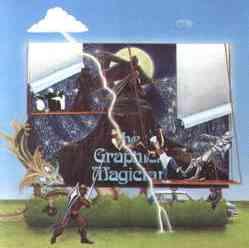Arcade-style Animated Action Games
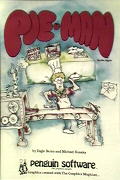 Not too long after The Graphics Magician was published, we got a call
from an amazing guy at Stanford University named
Eagle Berns. A great, creative
person, he went on to make his mark at Apple Computer (on the Macintosh team),
Micro Focus, and Oracle. But first and foremost he turned into a good friend who also happened to
write, with Michael Kosaka, the first game with Graphics Magician: Pie
Man. The game was loosely based on an I Love Lucy skit, with pies coming
rapidly off a conveyor belt while you try to put whipped cream and a cherry on top and put
the pie in a rack, while avoiding grease spots and obstacles. (Remember that these were
the days when state of the art was Break-Out,
Space Invaders, and Pac-Man.) A non-violent game with a bit of
personality was very unique and new. Eagle and his friend Holly Thomason would also later
go on to write one of our better adventure games, The Coveted Mirror.
Not too long after The Graphics Magician was published, we got a call
from an amazing guy at Stanford University named
Eagle Berns. A great, creative
person, he went on to make his mark at Apple Computer (on the Macintosh team),
Micro Focus, and Oracle. But first and foremost he turned into a good friend who also happened to
write, with Michael Kosaka, the first game with Graphics Magician: Pie
Man. The game was loosely based on an I Love Lucy skit, with pies coming
rapidly off a conveyor belt while you try to put whipped cream and a cherry on top and put
the pie in a rack, while avoiding grease spots and obstacles. (Remember that these were
the days when state of the art was Break-Out,
Space Invaders, and Pac-Man.) A non-violent game with a bit of
personality was very unique and new. Eagle and his friend Holly Thomason would also later
go on to write one of our better adventure games, The Coveted Mirror.
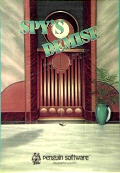
 At the AppleFest show in New York City we met Alan Zeldin, who'd written
a game called "Poof!". It met all the requirements of the time: the rules were simple, and
it was disturbingly addictive. Our Mary Locke changed the character into a spy toting a
briefcase, and the resulting game was titled Spy's Demise (with belated apologies
to the Safe House in Milwaukee).
This game sold rather well, and we converted it to Commodore 64 and Atari and sold into Sears
and Toys 'R' Us.... all those bastions of "success". It even has the distinction of being
one of the games copied and pirated under different names. We've seen Atari 2600 rip-offs of the
game idea, clones for the Macintosh, and variations of all types.
At the AppleFest show in New York City we met Alan Zeldin, who'd written
a game called "Poof!". It met all the requirements of the time: the rules were simple, and
it was disturbingly addictive. Our Mary Locke changed the character into a spy toting a
briefcase, and the resulting game was titled Spy's Demise (with belated apologies
to the Safe House in Milwaukee).
This game sold rather well, and we converted it to Commodore 64 and Atari and sold into Sears
and Toys 'R' Us.... all those bastions of "success". It even has the distinction of being
one of the games copied and pirated under different names. We've seen Atari 2600 rip-offs of the
game idea, clones for the Macintosh, and variations of all types.
 Bonus found in the vault: Alan's original "Poof!" version in DSK archive
Bonus found in the vault: Alan's original "Poof!" version in DSK archive

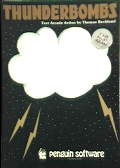
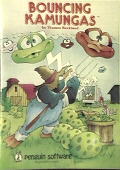 Tom Becklund, of Fargo, North Dakota
visited us at the Minneapolis Applefest and wowed us with some of his animation. We wound
up publishing two of his programs, Thunderbombs and Bouncing Kamungas.
The latter was indescribably wacky and must have been the product of environmental factors
including long winters and lots of flat, open land. It had something to do with being a
melon farmer and these bouncing guys squishing the melons you're growing, but you could
protect them with your pitchfork, but then watch out for thunderstorms... You had to be
there.
Tom Becklund, of Fargo, North Dakota
visited us at the Minneapolis Applefest and wowed us with some of his animation. We wound
up publishing two of his programs, Thunderbombs and Bouncing Kamungas.
The latter was indescribably wacky and must have been the product of environmental factors
including long winters and lots of flat, open land. It had something to do with being a
melon farmer and these bouncing guys squishing the melons you're growing, but you could
protect them with your pitchfork, but then watch out for thunderstorms... You had to be
there.
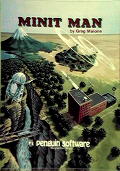 From the south, the hotbed of Shreveport, Louisiana also brought us Greg Malone. Greg had a helicopter action game that
became Minit Man. It was somewhat unique in that the action was spread
horizontally across three screens, and there was an arcade game within the arcade game. To
be successful you had to split your time appropriately between the two. We later worked
with Greg for a while on Moebius, which he eventually finished and published through Origin
Systems.
From the south, the hotbed of Shreveport, Louisiana also brought us Greg Malone. Greg had a helicopter action game that
became Minit Man. It was somewhat unique in that the action was spread
horizontally across three screens, and there was an arcade game within the arcade game. To
be successful you had to split your time appropriately between the two. We later worked
with Greg for a while on Moebius, which he eventually finished and published through Origin
Systems.

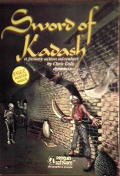 A small company in Oregon calling themselves Software
Entertainment Corporation had some neat educational programs and
some interesting animation work going on. Jeff Tunnell started the group, and they were
more interested in writing than publishing, so we published two excellent games from them:
Stellar 7 by Damon Slye and The Sword of Kadash by Chris Cole. The sales
of both of these were disappointing, because they were neat, neat games. Sword of
Kadash was well ahead of its time. An action-arcade style game, it had hundreds of
screens to negotiate, most of which had unique and interesting problems to solve. It was
almost an early version of a Sonic-the-Hedgehog type of game (moving around a
large map, solving puzzling situations to avoid traps). Stellar 7 was a copy of a
popular tank arcade game of the day, and after we released it back to Jeff (whose company
had adopted a now-familiar name, dynamix), Sierra On-Line picked it up and
marketed a newly-revised version for several more years.
A small company in Oregon calling themselves Software
Entertainment Corporation had some neat educational programs and
some interesting animation work going on. Jeff Tunnell started the group, and they were
more interested in writing than publishing, so we published two excellent games from them:
Stellar 7 by Damon Slye and The Sword of Kadash by Chris Cole. The sales
of both of these were disappointing, because they were neat, neat games. Sword of
Kadash was well ahead of its time. An action-arcade style game, it had hundreds of
screens to negotiate, most of which had unique and interesting problems to solve. It was
almost an early version of a Sonic-the-Hedgehog type of game (moving around a
large map, solving puzzling situations to avoid traps). Stellar 7 was a copy of a
popular tank arcade game of the day, and after we released it back to Jeff (whose company
had adopted a now-familiar name, dynamix), Sierra On-Line picked it up and
marketed a newly-revised version for several more years.
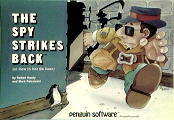 The Spy Strikes Back was the only home-grown arcade game we published
(the others were developed by outside authors). Mark and Bob Hardy designed it, and Bob did
the programming. The name and overall strategy of the game derived from the
moderately-successful Spy's Demise: there was no shooting, just a lot of
"sneaking around". (The subtitle was "How to Not Be Seen", shamelessly borrowed from
a Monty Python skit. The title itself was a take-off on another sequel of the time
that you might recall.) The game contained a nasty, wicked, code-breaking puzzle that
involved working all the way through the
multi-floor building maze and gathering clues. The clues were coded color/music tone
pairs, and if properly solved they instructed you to call a specific phone number and
identify yourself with a code name. This was one or two years after a book in England
called Masquerade caused a huge stir because it too contained clues... and
solving those clues would allow some person to find a very real hidden million-dollar
treasure. The book got all kinds of publicity and sold in huge numbers. For a while we
entertained the idea of doing something very similar with The Spy Strikes Back.
But ultimately we had visions of some 11-year-old hotshot gamer solving the whole thing
the first day and we chickened out. Shouldn't have. Too bad.
The Spy Strikes Back was the only home-grown arcade game we published
(the others were developed by outside authors). Mark and Bob Hardy designed it, and Bob did
the programming. The name and overall strategy of the game derived from the
moderately-successful Spy's Demise: there was no shooting, just a lot of
"sneaking around". (The subtitle was "How to Not Be Seen", shamelessly borrowed from
a Monty Python skit. The title itself was a take-off on another sequel of the time
that you might recall.) The game contained a nasty, wicked, code-breaking puzzle that
involved working all the way through the
multi-floor building maze and gathering clues. The clues were coded color/music tone
pairs, and if properly solved they instructed you to call a specific phone number and
identify yourself with a code name. This was one or two years after a book in England
called Masquerade caused a huge stir because it too contained clues... and
solving those clues would allow some person to find a very real hidden million-dollar
treasure. The book got all kinds of publicity and sold in huge numbers. For a while we
entertained the idea of doing something very similar with The Spy Strikes Back.
But ultimately we had visions of some 11-year-old hotshot gamer solving the whole thing
the first day and we chickened out. Shouldn't have. Too bad.
 The Spy Strikes Back DSK archive
The Spy Strikes Back DSK archive
 We published two of John "BEZ" Besnard's programs,
Pensate (described on another page) and Arcade Boot Camp.
Arcade Boot Camp was John's send-up of the typical arcade game of the day.
It consisted of a whole series of games that mimicked the arcade games of the period, so
you could polish your running, jumping, dodging, driving, flying, and shooting skills! It
was all done with you as "Private PeeVee" under the supervision of a boot camp instructor.
It was rather silly, and we liked it.
We published two of John "BEZ" Besnard's programs,
Pensate (described on another page) and Arcade Boot Camp.
Arcade Boot Camp was John's send-up of the typical arcade game of the day.
It consisted of a whole series of games that mimicked the arcade games of the period, so
you could polish your running, jumping, dodging, driving, flying, and shooting skills! It
was all done with you as "Private PeeVee" under the supervision of a boot camp instructor.
It was rather silly, and we liked it.
